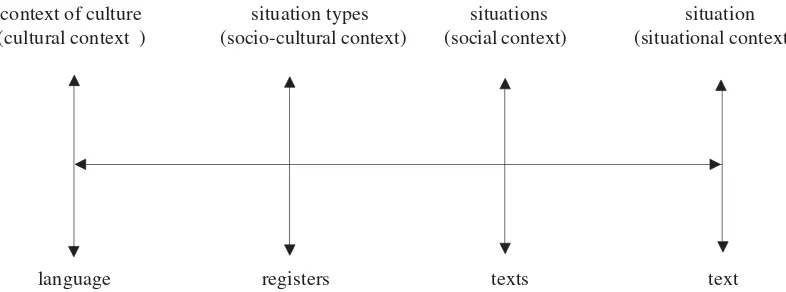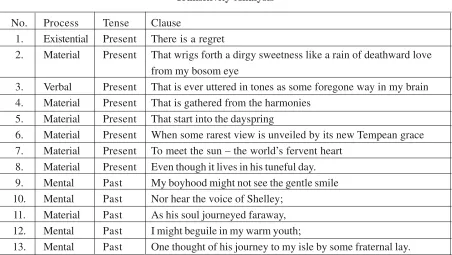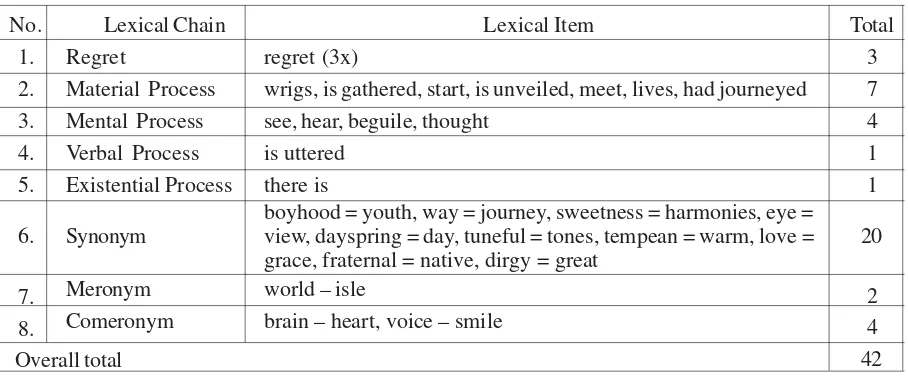Henriono Nugroho
Jurusan Bahasa dan sastra Inggris, Fakultas Sastra, Universitas Jember Jalan Jawa 19, Jember, Pos-el: h-nugroho@hotmail.com (Makalah diterima 22 November 2008 – Revisi 24 April 2009)
Abstract
This research aims to discuss literary work through stylistic analysis based on sistemic functional linguistics and literature semiotic system. The research methods used are the librarian study, descriptive method and objective intrinsic approach. The research result shows that the semantic analysis has produced the automatized linguistic meaning and foregrounded linguistic meaning. Next, the first meaning produces the subject matter and the secong meaning produces the literary meaning. Later, the literary meaning produces theme. Finally, it is proved that the subject matter tells about harmony; the literary meaning is about Shelley’s fame; and, the theme is about a famous poet.
Keywords: automatized linguistic meaning, foregrounded linguistic meaning, literary meaning, theme
Abstrak
PENYAIR TERKENAL DALAM PUISI HARPUR
Penelitian ini bertujuan mengkaji karya sastra melalui analisis stilistika berdasarkan ilmu bahasa fungsional sistemik dan sistem semiotik karya sastra. Metode penelitian menggunakan studi pustaka, metode deskriptif, dan pendekatan intrinsik objektif. Hasil penelitian menunjukkan bahwa analisis semantik menghasilkan makna bahasa latar belakang (the automatized linguistic meaning) dan makna bahasa latar depan (the foregrounded linguistic meaning). Makna pertama menghasilkan masalah utama (subject matter) dan makna kedua menghasilkan makna sastra (literary meaning). Makna sastra menghasilkan tema. Masalah utama berkisah tentang harmoni, makna sastra tentang ketenaran Shelley, dan tema tentang seorang penyair terkenal.
Kata kunci: makna bahasa latar belakang, makna bahasa latar depan, makna sastra, tema.
1. Introduction
Generally, there are several theories of stylistics namely formal, functional, feminine, pragmatic, affective, cognitive, pedagogical and critical (Webber, 1996). Particularly the functional stylistics includes Functionalism, Systemic Functionalism, Tagmemics, Prague School Functionalism and West Coast Functionalism (Matthiessen, 1995). Based on Systemic Functional Linguistics, language can be ordered in contexts with cline of instantiation (actualization over time): context of culture and language, situation types and
technol-ogy, economy, social organization and religion. The language order is outlined in the Figure 1.
In fact, a text is a semantic unit and a clause is a grammatical unit (Halliday, 1994). Then, se-mantics is an interface between context of situa-tion and lexicogrammar; in this sense the semantic systems are related “upward” to contextual sys-tems and they are related “downward” to lexicogrammatical systems (Halliday, 1993). The contextual systems are Field, Tenor and Mode. The semantic systems are Ideational, Interpersonal and Textual Meanings. The lexicogrammatical sys-tems are Complexing, Transitivity, Mood and Theme. In addition, the semantic systems are re-lated “sideways” to discoursal systems (Eggins, 1994). The discoursal systems are structural con-junction, lexical cohesion, conversational structure and grammatical cohesion. The interrelationship of situation, discourse, semantics and lexico-gram-mar is diagrammed in Table 1.
Moreover, literariness is defined as the dif-ference between automatization or background and defamiliarization or foreground (Jefferson, 1995:37). Background is also called ground, au-tomatization, familiarization, and the normal, ha-bitual, canonical, common, automatized or famili-arizing pattern, whereas foreground(ing) is also called figure, deautomatization, defamiliarization, and the foregrounded, motivated, prominent, dominant, deautomatized or defamiliarizing pat-tern (Jefferson 1995, Hasan 1985, Halliday 1971). Then, the concept of background and foreground is used by Hasan (1985: 99) to propose the
semiotic system of verbal art. The verbal art semiotics deals with verbalization, symbolic ar-ticulation and theme. Verbalization itself is the semiotic system of language concerned with pho-nology, lexicogrammar and semantics; especially, verbalization —the lowest stratum— is where the point of primary contact with work reveals the meaning of language (the deep level of meaning). Symbolic articulation —the middle stratum— is where the deep level of meaning functions as a sign, symbol or metaphor for the deeper level of meaning. Finally, Theme —the highest stratum— is where the deeper level of meaning creates the deepest level of meaning.
This article is concerned with a stylistic analy-sis on a poem of Charles Harpur as follows.
Disappointment
There is a regret that from my bosom eye Wrigs forth a dirgy sweetness, like a rain Of deathward love; that ever in my brain Is uttered in tones as some foregone way; Is gathered from the harmonies that start Into the dayspring, when some rarest view Is unveiled by its Tempean grace anew To meet the sun — the great world’s fervent heart. Even though living in his tuneful day, My boyhood might not see the gentle smile, Nor hear the voice of Shelley; as faraway His soul had journeyed; I might beguile In my warm youth; by some fraternal lay, One thought of his journey to my native isle.
context of culture situation types situations situation (cultural context ) (socio-cultural context) (social context) (situational context)
language registers texts text
2. The Semiotic System of Language
2.1 Logical Meaning, Logical Meta-function or Logical Semantics
Logical meaning is a resource for con-structing logical relation (Halliday, 1994:36) and the logical meaning describes a clause type (clause complex). In fact, the poem is realized by two clauses complexes consisting of two main clauses and eleven expanding clauses. Out of eleven ex-panding clauses, there are four hypotactic elabo-rating clauses, four hy-potactic enhancing clauses and three para-tactic extending clauses. Thus, elaboration and enhancement are the automatized pat-terns, because the poem is frequently real-ized by the two patterns. Then, logical meaning is realized by complexing, and the complexing analy-sis is presented in Table 2.
2.2 Experiential Meaning, Experiential Metafunction or Experiential Se-mantics
Experiential meaning is a resource for con-struing experience (Halliday, 1994: 36) and the experiential meaning discusses a process type (processes). Actually, the poem is encoded by seven clauses of material process, four clauses of mental process, one clause of relational process and one clause of verbal process. Moreover, the poem is encoded by eight clauses of present tense and five clauses of past tense. In other words, material process and present tense are the automa-tized patterns because they are frequently used in the poem. Then, experiential meaning is en-coded by transitivity, and the transitivity analysis is dis-played in Table 3.
Table 1
The Relation of Context, Text, and Clause
Note: # Logical Meaning and Experiential Meaning = Ideational Meaning * Including Reference, Substitution, Ellipsis, and Cohesive Conjunction ** Including Reiteration and Collocation
*** Including Polarity and Modality
Textual Meaning Situation
Field Subject Matter
Tenor Role Relation
Mode Rhetoric
Discourse Structural Conjunction
** Lexical Cohesion
Conversational Structure
* Grammatical Cohesion
Semantics # Logical Meaning
# Experiential Meaning
Interpersonal Meaning
Lexicogrammar Complexing Transitivity *** Mood Theme
Context
T
ext
Clause
2.3 Logogenetic Process
According to Halliday and Matthiessen (1998:184—5), logogenesis is a process of mak-ing meanmak-ing through an instantial sys-tem (a changing system) when text unfolds (in the un-folding text). The speaker/writer uses the instantial system (the changing system) as a resource to create a text, whereas the listener/reader uses
struc-ture (Martin, 1985), staging strucstruc-ture (Plum, 1988) and generic structure (Eggins, 1994). In this poem, shifts (changes) are described as fol-lows: Shift from material process (clause 8) to mental process (clause 9) coincides with shift
from The Disappearance of Harmonies to The Disappearance of Percy Bysshe Shelley.
Thus, the changing system of process and tense is used to make meanings, and the logogenetic process is outlined in Table 4.
Table 2
There is a regret
That wrigs forth a dirgy sweetness like a rain of deathward love from my bosom eye
That is ever uttered in tones as some foregone way in my brain That is gathered from the harmonies
That start into the dayspring
When some rarest view is unveiled by its new Tempean grace To meet the sun – the world’s fervent heart
Even though it lives in his tuneful day. My boyhood might not see the gentle smile Nor hear the voice of Shelley;
As his soul journeyed faraway, I might beguile in my warm youth;
One thought of his journey to my isle by some fraternal lay.
2.4 Lexical Cohesion
A poem is realized by several lexical chains and each chain consists of a number of lexical items. As a matter of fact, the poem is realized by eight lexical chains consisting of 42 lexical items. The lexical chains include regret (3), material process (7), mental process (4), verbal process (1), exis-tential process (1), synonym (20), meronym (2), and comeronym (4). In other words, the poem is frequently realized by the main lexical chains of
regret, material process and synonym and the lexi-cal cohesion is shown in Table 5.
1.2 Subject Matter
Halliday (1993:110) states that Field includes sub-ject matter as one special manifestation and Halliday (1993:143) claims that Field is realized by Experiential Meaning. Then, Eggins (1994:113) explains that Field is encoded by Experiential
Meaning and lexical cohesion. In addition, Butt (1988:177) describes that subject matter is ex-pressed by lexical chains and specifically subject matter is indicated by the main lexical chains (Butt, 1988:182). Thus, subject matter is realized by Experiential Meaning and lexical cohesion (lexical chains).
Table 3
There is a regret
That wrigs forth a dirgy sweetness like a rain of deathward love from my bosom eye
That is ever uttered in tones as some foregone way in my brain That is gathered from the harmonies
That start into the dayspring
When some rarest view is unveiled by its new Tempean grace To meet the sun – the world’s fervent heart
Even though it lives in his tuneful day. My boyhood might not see the gentle smile Nor hear the voice of Shelley;
As his soul journeyed faraway, I might beguile in my warm youth;
One thought of his journey to my isle by some fraternal lay.
3. The Semiotic System of Verbal Art 3.1 Verbalization: The Deep Level of Meaning In section 2.1, both elaboration and en-hancement are automatized, so a combination of extension and enhancement is foregrounded. Thus, the foregrounding of logical relation takes place in clauses 9, 10, 11, 12 and 13. In section 2.2, ma-terial process is automatized, so other processes (mental, verbal and existensial) are foregrounded. Therefore, the foregrounding of process occurs in clauses 1, 3, 9, 10, 12 and 13. In section 2.2, present tense is automatized, so past tense is foregrounded. Accordingly, the foregrounding of tense exists in clauses 9, 10, 11, 12 and 13. Fi-nally, patterns of foregrounding are mapped out in Table 7.
Table 7 above shows that patterning of the various foregrounded patterns points toward clauses 9, 10, 11, 12, and 13. Thus, consistency of foregrounding converges toward the last clause complex because of logical relation, process and tense. Then, the consistency of foregrounding makes the foregrounded patterns of the last clause complex produce consistently foreground-ed meaning which is also called the deep level of meaning and the first order meaning. In brief, the
consistently foregrounded meaning is called the deep level of meaning: My boyhood might not see the gentle smile, nor hear the voice of Shelley; as faraway his soul had journeyed; I might beguile in my warm youth; by some fraternal lay, one thought of his journey to my native isle.
3.2 Symbolic Articulation: The Deeper Level of Meaning
The deep level of meaning functions as the sign, symbol or metaphor of the deep level of meaning which is also called the second order meaning and literary meaning. In section 3.1, the deep level of meaning is produced by the foregrounded pat-terns of logical relation, process and tense. Then, the deep level of meaning suggests that I did not see and hear the fame of Percy Bysshe Shelley when I was a small boy even though people thought that he had come to my home land. In summary, the deeper level of meaning concerns with the fame of Shelley.
that Theme is the deepest level of meaning in ver-bal art; it is what a text is about when dissociated from the particularities of that text. In its nature, the Theme of verbal art is very close to generali-zations which can be viewed as a hypothesis about some aspects of the social life of man. Moreover,
Hasan (1985:54) adds that the deepest level of mean-ing is a meanmean-ing that arises from saymean-ing one thmean-ing and meaning another. In this poem, saying one thing (the fame of Shelley) means another meaning (the fa-mous poet). In conclusion, the deepest level of mean-ing deals with the famous poet.
Table 4 Cf. Latent Patterning
Existential Process
Material Process Mental Process Mental Process
Episodic Shift Cf. Textual Structure
The Disappearance of
Harmonies
The Disappearance of Percy Bysshe Shelley
4. Conclusion
The lexicogrammatical analysis produces seman-tic components and there are two kinds of se-mantic patterns such as automatized and foregrounded. On the one hand, the automatized pattern produces the automatized meaning, and in turn the automatized meaning produces subject matter. At the stratum of Verbalization, on the other hand, consistency of foregrounding makes some foregrounded patterns produce consistently foregrounded meaning which is also called the
deep level of meaning and the first order meaning. At the stratum of symbolic articulation, the deep level of meaning functions as symbol, sign or meta-phor of the deeper level of meaning which is also called the second order meaning and literary mean-ing. At the stratum of Theme, the deeper level of meaning creates the deepest level of meaning which is also called Theme and the third order meaning. In summary, there is a symbolic relation between lexico-grammar and Theme in verbal art. Then the meanings in the poem are outlined in Table 8.
Table 5
wrigs, is gathered, start, is unveiled, meet, lives, had journeyed see, hear, beguile, thought
is uttered there is
boyhood = youth, way = journey, sweetness = harmonies, eye = view, dayspring = day, tuneful = tones, tempean = warm, love = grace, fraternal = native, dirgy = great
world – isle
brain – heart, voice – smile
Table 6
The Analysis of Relational Process
No. Actor Process Goal Circumstance
1. A regret wrigs forth a dirgy sweetness
-2. A regret is gathered from the harmonies into the dayspring
3. Some view is unveiled by a new grace
-4. A new grace meets the sun
-5. The sun lives - in the tuneful day
Table 7
Patterns of Foregrounding
No. 1. 2. 3. 4. 5. 6. 7. 8.
9. 10. 11. 12. 13.
Logical Relation
-x x x x x
Process x -x
-x x -x x
Tense
-x x x x x
Table 8
Meanings of Verbal Art Semiotics
Verbalization
Consistenly Foregrounded Meaning The Deep Level of Meaning The First Order Meaning
Symbolic Articulation Literary Meaning
The Deeper Level of Meaning The Second Order Meaning
Theme Theme
The Deepest Level of Meaning The Third Order Meaning
REFERENCES
Butt, David. 1988. “Randomness, Order and the Latent Patterning of Text” in David Birch and Michael O’ Toole (eds.) Functions of Style. London: Pinter Publishers.
Butt, David et al. 1995. Using Functional Gram-mar. Sydney: Macquarie University.
Eggins, Suzanna. 1994. An Introduction to
Sys-temic Functional Linguistics. London:
Pinter Publishers.
Halliday, MAK. 1993. Language as a Social
Semiotic. London: Edward Arnold.
Halliday, MAK & Christian Matthiessen. 1999.
Construing Experience through Mean-ing: a Language-Based Approach to Cog-nition. Berlin: de Gruyter.
Hasan, Ruqaiya. 1985. Linguistics, Language
and Verbal Art. Melbourne: Deakin
Uni-versity Press.
Hasan, Ruqaiya. 1988. “The Analysis of One Poem: Theoretical Issues in Practice”in David Birch and Michael O Toole (eds.)
Functions of Style. London: Pinter
Pub-lishers.
Hasan, Ruqaiya. 1996. “On Teaching Literature Across Cultural Distances” in Joyce E. James (ed.), The Language-Culture
Con-nection. Anthology series 37. Singapore:
Seameo Regional Language Center
Jefferson, Ann and David Robey. 1995. Modern
Literary Theory. London: B.T. Batsford
Ltd.
Kluckhohn, C. 1953. “Universal Catego-ries of Culture” in A.L. Kroeber (ed.). Anthropol-ogy Today. Chicago: Uni-versity Press.
Martin, J.R. 1985. “Process and Text: Two As-pects of Semiosis” in Benson and Graves (eds.) Systemic Perspectives on
Dis-course. Norwood, New Jersey: Ablex.
Martin, J.R. 1992. English Text System and
Structure. Amsterdam: John Benjamins
Publishing.
Mukarovsky, Jan. 1977. The Word and Verbal Art. tr. J.Burbank and P. Steiner. New Ha-ven: Yale University Press.
Matthiessen, Christian. 1995. Lexicogram-matical Cartography: English Sys-tems.
Tokyo, Taipei, Dallas: International Lan-guage Sciences Publishers.
Pradopo, R.D. 1996. Pengkajian Puisi.
Yogyakarta: Gajah Mada University Press.
Preminger, A. 1974. Princeton Encyclope-dia of
Poetry and Poetics. Princeton: Princeton
University Press.
Plum, G.A. 1988. Text and Contextual Condi-tioning in Spoken English: A Genre Based
Approach. Unpublished PhD Thesis.




